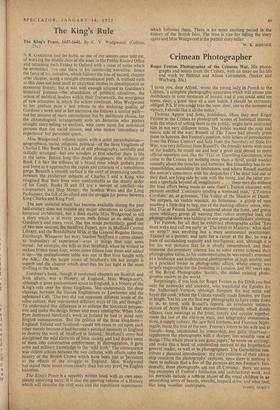The King's Rule
S. R. GARDINER had the habit, so one of my seniors once told me, of working the middle days of the week in the Public Record Office and returning each Friday to Oxford with a mass of notes which he embedded 'hen and there in his continuing narrative : hence the form of his narrative, which follows the line of record, chapter after chapter, along a straight chronological path. A method such as this does not lend itself to analytical studies in constitutional or economic history; but it was well enough adapted to Gardiner's historical purpose—the elucidation of political situations, the action of political leaders within their framework, the emergence of new situations in which the action continues. Miss Wedgwood in her preface pays a just tribute to the enduring quality of Gardiner's work and in her narrative she follows a similar path— not for reasons of mere convenience but by deliberate choice, for the chronological arrangement suits an historian who prefers straight story-telling to analysis, who cares more for individual persons than for social classes, and who makes 'immediacy of experience' her persistent quest.
Miss Wedgwood's volume opens with a quiet perambulation— geographical, social, religious, political—of the three kingdoms of Charles I. Her Book I is a kind of still photography, carefully and skilfully arranged—but one wonders at first whether there is life in the scene. Before long this doubt disappears; the stillness of Book I is like the stillness of a broad river which gathers pace and force as it approaches the rapids and cataracts of a tumultuous gorge. Beneath a smooth surface is the swirl of impending conflict between the exuberant subjects of Charles I and a King who imagined that their lives were conformable to the stately order of his Court. Books II and III are a torrent of conflict—the Covenanters and Ship Money, the Scottish' Wars and the Long Parliament, the fall of Strafford and the struggle for power between King Charles and King Pyrri.
The new material which has become available during the past half-century does not require any major alterations to Gardiner's historical architecture, but it does enable Miss Wedgwood to tell a story which is at many points both firmer in its detail than Gardiner's and more vivid. She has made particularly good use of two new sources, the Strafford Papers, now in Sheffield Central Library, and the Breadalbane MSS. in the General Register House, Edinburgh. Whenever her story touches Strafford it comes closest to 'immediacy of experience'—even in things that may seem trivial: for example, she tells us that Strafford, when he wished to reckon fifteen times four, wrote down fifteen four times and added it up—'the multiplication table was not at that time taught with the ABC.' On the larger issues of Strafford's life her insight is superb and the chapter which describes his last fight is the most thrilling in the book.
which followed them. There is no more exciting period in the history of the British Isles. The time is ripe for telling the story again and Miss Wedgwood is the perfect story-teller.
W. K. HANCOCK


































 Previous page
Previous page